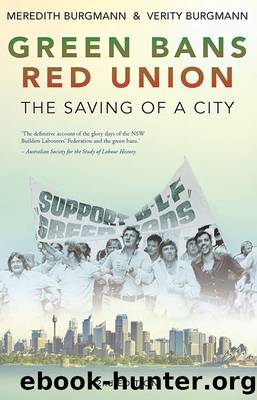Green Bans, Red Union by Meredith Burgmann Verity Burgmann

Author:Meredith Burgmann,Verity Burgmann
Language: eng
Format: epub
Publisher: University of New South Wales Press
Published: 2017-01-18T16:00:00+00:00
MERRYLANDS (AUGUST 1973)
Lack of planning was also apparent in Merrylands, where a factory, greatly desired elsewhere, was proposed for an area where it was not wanted. In West Merrylands, known unofficially as Greystones, in western suburban Sydney, the local council gave approval to Fowler Ware Industries to turn 6 hectares of forest into a factory for making vitreous china bathroom items. Initially residents thought the council were employing the workers to turn part of the forest into a park; as they started excavating it was naively assumed a swimming pool was being provided. When the nature of the development became known, a citizensâ action group protested strongly with petitions, demonstrations and arguments at council meetings.45
When work nonetheless proceeded on the factory, the residents turned to the NSWBLF in August, which accordingly withdrew all workers from the Merrylands construction site. The residents argued that they wanted the forest to remain as it was or be turned into a park, and they did not want any more industrial sites in their developing residential area. They requested Fowler and the Minister for Decentralisation to build the proposed factory in the Mudgee-Gulgong area, where the clays for the china were extracted. While discussions continued between the NSWBLF and Fowler, and the Total Environment Centre carried out an âin depth studyâ of the environmental effects of the proposed factory, the Resident Action Group in Mudgee asked the Mudgee Municipal Council to take action to attract the industry to the area. This council expressed its surprise that the Minister for Decentralisation had not proposed the Mudgee area as a site for the factory in the first place and agreed with the Resident Action Group that strong efforts should be made to gain the industry, which would employ 300 to 400 people.46
Because the union had persuaded Fowler to carry out an environmental impact study and had suggested the Total Environment Centre as one of two appropriate consultants, this event was twisted beyond recognition by a Liberal MLA in parliament. In a curious sophistication of traditional anti-Communism, Mr Barraclough declared the NSWBLF, under âTrotskyiteâ leadership, was blackmailing companies by placing bans on building projects and then extorting money from the companies on behalf of the Environment Centre: âPeople are paying out in fear to avoid BLF black bansâ. The union replied with a press statement, explaining that when the company involved had indicated that it was willing to modify its proposals and commission an environmental impact study, the union had told the company it was for the residents to decide whether the amended propositions were satisfactory: âAt no time and in no discussion with us have the company or ourselves made any mention of payment of any moneyâ. The union called for an inquiry into the building industry which should âthoroughly probe the facts ⦠including the commercial rampages by developers while community needs go neglectedâ. Mundey said Barracloughâs remarks, which he had declined to repeat outside parliament, were the sort of false allegations made time and again
Download
This site does not store any files on its server. We only index and link to content provided by other sites. Please contact the content providers to delete copyright contents if any and email us, we'll remove relevant links or contents immediately.
Kathy Andrews Collection by Kathy Andrews(10509)
The remains of the day by Kazuo Ishiguro(7543)
Spare by Prince Harry The Duke of Sussex(4188)
Paper Towns by Green John(4165)
The Body: A Guide for Occupants by Bill Bryson(3791)
Be in a Treehouse by Pete Nelson(3206)
Harry Potter and the Goblet Of Fire by J.K. Rowling(3025)
Goodbye Paradise(2950)
Never by Ken Follett(2873)
Into Thin Air by Jon Krakauer(2695)
The Remains of the Day by Kazuo Ishiguro(2614)
The Genius of Japanese Carpentry by Azby Brown(2602)
The Cellar by Natasha Preston(2592)
Drawing Shortcuts: Developing Quick Drawing Skills Using Today's Technology by Leggitt Jim(2529)
120 Days of Sodom by Marquis de Sade(2428)
Architecture 101 by Nicole Bridge(2348)
The Man Who Died Twice by Richard Osman(2290)
Machine Learning at Scale with H2O by Gregory Keys | David Whiting(2267)
Fairy Tale by Stephen King(2058)
